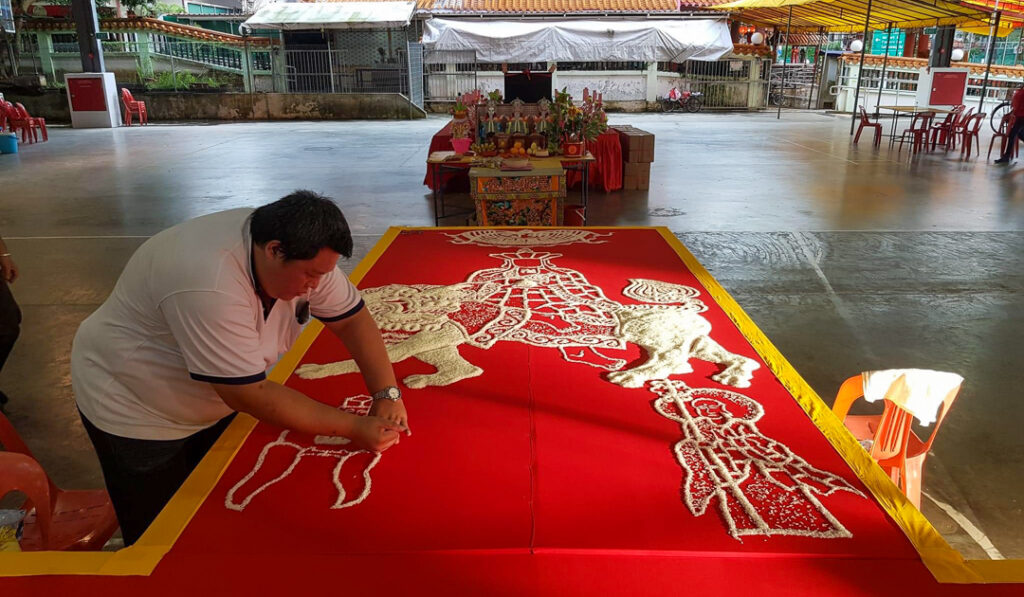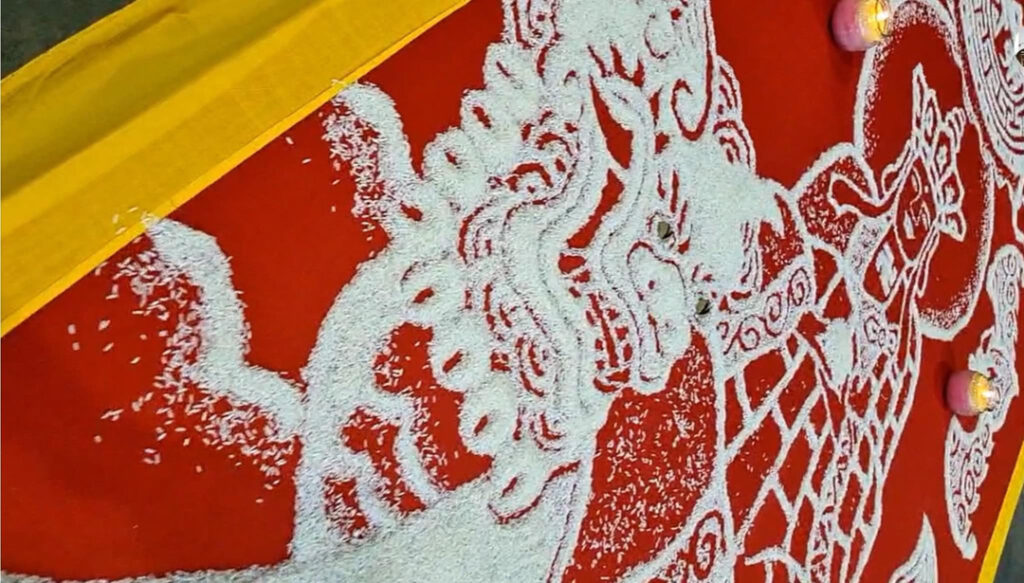Angela Sim explains the significance of the Teochew ritual of rice drawing that is still practised in Singapore’s temples.
Rice is a crucial component of any Chinese meal, a centrepiece of the table, surrounded by side dishes, like that of a conductor and his orchestra.
In Asia, a common greeting is to ask, “Have you eaten Nǐ chī bǎo fànle ma你吃饱饭了吗?” This expression reflects a person’s genuine concern, much like how our mothers and grandmothers would remind us not to skip meals. In Chinese culture, greetings are centred around food, and sharing a meal is seen as a sign of well-being and health.
Interestingly, we don’t simply “cook” rice; we “build” it. This term reflects the time and care invested into its preparation. Rice is a staple in many forms, and it can be transformed into congee, rice cakes, rice crackers, noodles, and even alcohol. Its versatility is a significant part of our daily lives.
Rice comes in many varieties—white, brown, black, and even red. Each type of rice and every meal prepared with it carries unique meanings and wishes deeply rooted in tradition and affection. The Chinese character for spirit or Chi氣 even includes the character for rice Mǐ 米 at its centre, setting the tone that rice is the essence and foundation of everything.
Rice is chosen as an ingredient of choice used in certain religious rituals we are going to talk about today in this article due to the character Mǐ米 symbolising the ten directions. Most commonly known are the five directions central, north, south, east and west. Upwards, downwards, etc., forms the other five. In essence, the character 米represents all directions, worshipping space and time, in this case, is used to garner universal power from its surroundings.
天雨栗 鬼夜哭
粟米像雨一样从天而降,鬼害怕的在夜里哭
This phrase “Millet like rain falls from the sky, and ghosts weep at night” can be seen as a poetic expression of a world in turmoil. Let’s try to imagine a time when the natural and supernatural realms are so disrupted that even the skies shed grains like tears, and spirits are driven to mourn in the darkness.
It expresses the mood of disorder where even commonplace items, millet on the ground, for instance, become disturbing prophecies. The imagery here suggests that the world has turned upside down in some way, which has caused both the living and the departed to be unsettled as the environment around them no longer behaves as expected.
倉頡 Cangjie, a legendary four-eyed historian during the reign of Emperor Xuanyuan 軒轅, created a written form of the Chinese language that gave it a new birth. Numerous inventions and innovations have been attributed to the emperor. Some to note are the lunar calendar, Taoism, the compass needle, and the earliest forms of writing.
Thus in an ancient Taoism ritual of ‘铺灯, 故道法划地为狱,以米为界,后世凡铺灯,皆用米’. The land is regarded as a prison and rice is used to serve as an earthly boundary. The next generation is the lighted lamps, though sometimes rice will serve a similar purpose. A Taoist priest leads the ceremony held on the last evening of a funeral wake with chanting of Buddhist scriptures and prayers Guān dēng kē yí or Gueng Deng Kue Ngi 關燈科儀, a large-scale rice drawing Mǐ zhuō or Bhi Ceng 米桌 or Yōumíng tú‘ or Hiun Meng Dou 幽冥圖 is sometimes incorporated into the ritual, supported by traditional musicians who provide vocal and instrumental accompaniment. A crucial element of the ritual is a paper lantern, which is used to guide the spirit of the deceased. The priest holds the lantern and leads the family in a symbolic crossing of a bridge known as the Nàihé qiáo 奈何桥 , facilitating the spirit’s transition to the afterlife. This concept aligns with Taoist beliefs about a spirit’s “leftover business,” reflecting the notion that once a spirit crosses this bridge, it can no longer return to address any unresolved matters from its earthly life. This adds a layer of poignancy to the ritual, emphasizing the finality of the transition and the importance of letting go.
In the Teochew ritual 關燈科儀 of rice table drawings 米桌 or 幽冥圖, a skilled Master uses raw rice grains to create freehand drawings and inscriptions on a cloth tapestry laid out on a sacrificial table. These large-scale artworks, which can exceed the size of an adult human, can take over eight hours to complete.

Master Francis Tan Kwee Chye, in Singapore, is one such craftsman who is still practising this art form. He works tirelessly with sacks of raw rice grains and draws large-scale drawings executed from memory, without the use of patterns. The size of these rice table drawings does vary, depending on space as well as the requirements of the ritual.
The most common rice drawing Master Francis paints with rice is that of 大愿地藏王菩萨 Kṣitigarbha Bodhisattva of the Great Vow and 十殿閻君 the 10 Kings of Hell. An invite has been extended to summon these 11 to preside over the ritual: the rice relief signifies their presence. This ritual is a deeply symbolic gesture, where the intricate rice drawings are not just art but act as a form of communication bearing heartfelt blessings and condolences for the departed.
Through these carefully crafted images, the living express their love and respect, offering comfort to the deceased as they embark on their journey to the afterlife. It can be witnessed during a Hsien deng 善堂, a Teochew funeral ritual of a similar name, which is usually performed on the final night of wake which ranges from three to seven days, aimed at guiding the spirit of the deceased to the afterlife. According to spiritual beliefs, the spirit of the deceased may wander in the mortal realm if it is unable to transition into the underworld, risking becoming lost or vengeful. This ritual ensures that the deceased is cared for and passes peacefully. Rice drawings are sometimes also presented during a De cáng bǎo dēng 地蔵寶燈 ritual, the offering of a lamp or light to Kṣitigarbha Bodhisattva of the Great Vow signifies “掌上明珠,光照大千世界; 手中金锡,振开地狱之门。手中金锡,振开地狱之门, to illuminate and to pray for the sufferings of all sentient beings.
Imagine spending over eight hours meticulously drawing a detailed picture using rice, guided only by Master Francis’s left hand. Then, in a fleeting moment, all that effort is erased in just minutes. At the end of the ritual, the Master gently sweeps the rice into a mound, dissolving the intricate designs and marking the end of a profound, symbolic act.
These rice drawings, which can range from symbolic Chinese wordings to large-scale murals or even a mixture of both can sometimes be seen at funerals, seventh-month festivals for both ancestors and wandering spirits such as Pudu 普渡 or Universal Salvation Ritual 萬緣勝會or Yulan penhui 盂兰盆会 in Buddhism organised by Shang tang 善堂as well as birthdays of deities 神诞 at temples. Sometimes, a major Buddhist rite called Shuilu fahui 水陆法会, a plenary water and land ritual is also conducted during this time for the deceased and all beings.
Something worth mentioning is the presence of Shang Tang 善堂’, some of which adopt the precepts of Xian Tian Jiao 先天教, a syncretic religious sect that originates from China, combining key teachings of Buddhism, Taoism, Confucianism, Christianity and Islam. Towards the end of the Ming dynasty (1368–1644), these 善堂 started out as benevolent societies, which later developed into charitable temples, as seen throughout South East Asia, namely Singapore and Malaysia. Quite similar to clans in the early days, this 善堂offered refuge to chaste widows, orphans and young girls abandoned at birth. As seen in one such temple in Singapore, Po Leung Kuk 保良局, or the “Society for the Protection of Innocents” established in 1885, provided refuge and rehabilitation for the victims or Mui tsai of forced prostitution and those who have escaped from brothels.中華善堂藍十救濟總會 Blue Cross Charitable Institution, a notable charitable hall made up of multiple Teochew counterparts, established during WW2 in Singapore, in reaction to the hardships endured during the war and the Japanese occupation. These benevolent societies engage in social relief efforts, which encompassed medical care, support for the impoverished, and the offering of free burials for the deceased as well as assisting in the installation of ancestral tablets and urns. Fuji 扶乩 or planchette divination or spirit writing, of Taoist nature, is a common activity seen at these 善堂 though chanting of Buddhist scriptures is being observed.
These cherished charitable and religious folk customs of the Teochew or Chaozhou 潮洲 people are rich in tradition and deeply tied to local practices. The devotional ceremonies held in Singapore’s temples, whether grand or modest, are rooted in traditional etiquette and rituals. They vividly reflect the religious and cultural customs of the Teochew community. For the local Teochew population, these practices are vital in preserving and passing down the cultural heritage of their ancestral hometown, maintaining a strong connection to their roots even being far from home.
As Singapore’s younger generation becomes more influenced by Western ideals, their perspectives, values, and religious beliefs have shifted significantly. Many young people today are less familiar with the Teochew dialect and struggle with their ethnic Chinese language skills. This gap in understanding makes it difficult for them to follow the traditional scriptures chanted during rituals, and they may find it challenging to grasp the deeper spiritual meanings behind these ceremonies, as mentioned above in this article. As a result, some view these customs as mere superstitions rather than cherished cultural practices.
To genuinely honour and preserve Teochew rituals and heritage, it’s vital to balance charitable efforts with the safeguarding of cultural traditions. By integrating both elements, Chaoren Shantang 潮人善堂 can continue to highlight its rich heritage and humanistic values. It’s not solely about maintaining past customs, but also about reimagining and revitalizing them to connect with today’s generation. This approach ensures that these folk practices stay dynamic and relevant while still respecting their deep-rooted traditions.
References
An, Liu, John S Major, Sarah A Queen, Andrew Seth Meyer, Harold D Roth, Michael Puett, and Judson Murray. 2010. The Huainanzi. New York Columbia University Press.
Chee-Beng, Tan. 2012. “Shantang Charitable Temples in China, Singapore, and Malaysia.” In Sun Yat-Sen University. Vol. 71. © Nanzan Institute for Religion and Culture: Asian Ethnology 75–107.
Grace, Paul. 1989. The Poh Leung Kuk in Singapore. ScholarBank@NUS Repository: On shelf at Lee Kong Chian Reference Library Level 11.
Ivanhoe, Philip J, and Bryan William. 2007. Readings in Classical Chinese Philosophy. 2nd ed. Vol. p. 380. Indianapolis: Hackett Publ.
Rong Hao Shannon, Lee, Ong Yu Wen, Ong Zi Ying, and Wang Yifan. 2017. “CHEK SIAN TNG 积善堂.” In SSA1208 the EVERYDAY LIFE of CHINESE SINGAPOREANS, 1–11. National University of Singapore: Singapore Historical GIS.
Shue, Vivienne. 2006. “The Quality of Mercy.” Modern China 32 (4): 411–52. https://doi.org/10.1177/0097700406291788.
Zhang, Shudong. 2005. 《中华印刷通史》 [a General History of Chinese Printing] (in Chinese). Pp. ch.3, sec.1. XingCai Literary Foundation.
新加坡)李志贤. 2021. 蓝十春秋:新加坡潮人善堂考. 社会科学文献出版社.
同德善堂念心社. 1999. 同德善堂念心社四十年简介(1949-1989). Pg 174. Tong de shan tang nian xin she, 1999.
About Angela Sim
 Angela Sim is an Australia-based researcher of Asian heritage and culture. She uses her platform as a media content creator to explore areas such as folk religion, Peranakan culture, and sunset industries including Chinese woodblock printing, effigy restoration, and lantern making, to name a few. Watch youtube.com/@HakkaMoi
Angela Sim is an Australia-based researcher of Asian heritage and culture. She uses her platform as a media content creator to explore areas such as folk religion, Peranakan culture, and sunset industries including Chinese woodblock printing, effigy restoration, and lantern making, to name a few. Watch youtube.com/@HakkaMoi






